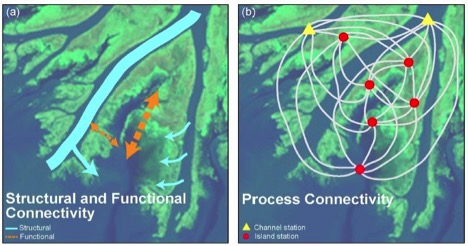 Research Project Full Title: The Delta Connectome: Structure and Transport Dynamics of Delta Networks across Scales and Disciplines
Research Project Full Title: The Delta Connectome: Structure and Transport Dynamics of Delta Networks across Scales and Disciplines
Principal Investigator(s): Paola Passalacqua
Researchers: Alicia Sendrowski, Furkan Isikdogan
Sponsor(s): National Science Foundation
Full Abstract:
Rich in ecosystem diversity and economic resources, deltas host approximately half a billion people. However, anthropogenic disturbance, natural subsidence, and eustatic sea-level rise are major causes of threat to deltas and managing and preserving these dynamic centers of activity is imperative. This CAREER project creates a research/educational framework, the Delta Connectome, based on the general idea of a delta as a directed network of connected paths, which interact continuously at a broad range of spatial and temporal scales that dictate system response to change. Such relationships have been established in many fields, from metabolic networks and food webs, to neural interactions, but similar work on deltaic systems has yet to be developed. The project will use a network-theoretic framework, incorporating remote sensing data analysis, numerical modeling, and field observations, to develop software that will characterize the spatial and temporal variability of deltas and quantify couplings among variables within these systems. How the system responds to change and its resilience to natural and anthropogenic perturbations at varying spatial and temporal scales will then be determined. Specific goals of this project include: (i) the objective quantification of delta morphologic features to identify the signature of vegetation, anthropogenic disturbance, and processes responsible for delta formation and evolution; (ii) the development of an automatic image processing-based tool for the extraction of relevant information from remotely sensed data; (iii) the identification of the environmental controls on channel network and shoreline dynamics through coupled analysis of extracted features; and (iv) the quantification of strength, directionality, statistical significance, and scale of couplings among key variables and the effect of anthropogenic disturbance and change on such couplings. Ultimately, the software will provide a valuable tool for studying deltaic systems and informing coastal restoration.
Human-induced activities and climatic shifts are significantly impacting deltas around the world. A quantitative description of the form and structure of deltas and their dynamics is fundamental to address how they react to changes in climatic forces and human pressure. The project provides an innovative combination of teaching, training, learning, and dissemination activities to communicate these impacts to the research community, the public, and future scientists. The tools developed from the project will be released as open source software through the Community Surface Dynamics Modeling System (CSDMS) repository and National Center for Earth-Surface Dynamics (NCED) website. NCED Summer Institutes will provide annual tutorials on software use and the tools will also be integrated into courses taught at the University of Texas at Austin (UT-Austin). Additionally, an Exploration Unit directed to high school students will be developed for the UTeach Engineering Program at UT-Austin. In this unit, remote sensing imagery and visual arts will be used to present environmental problems such as coastal restoration and the effect of humans and climate on the natural environment.
